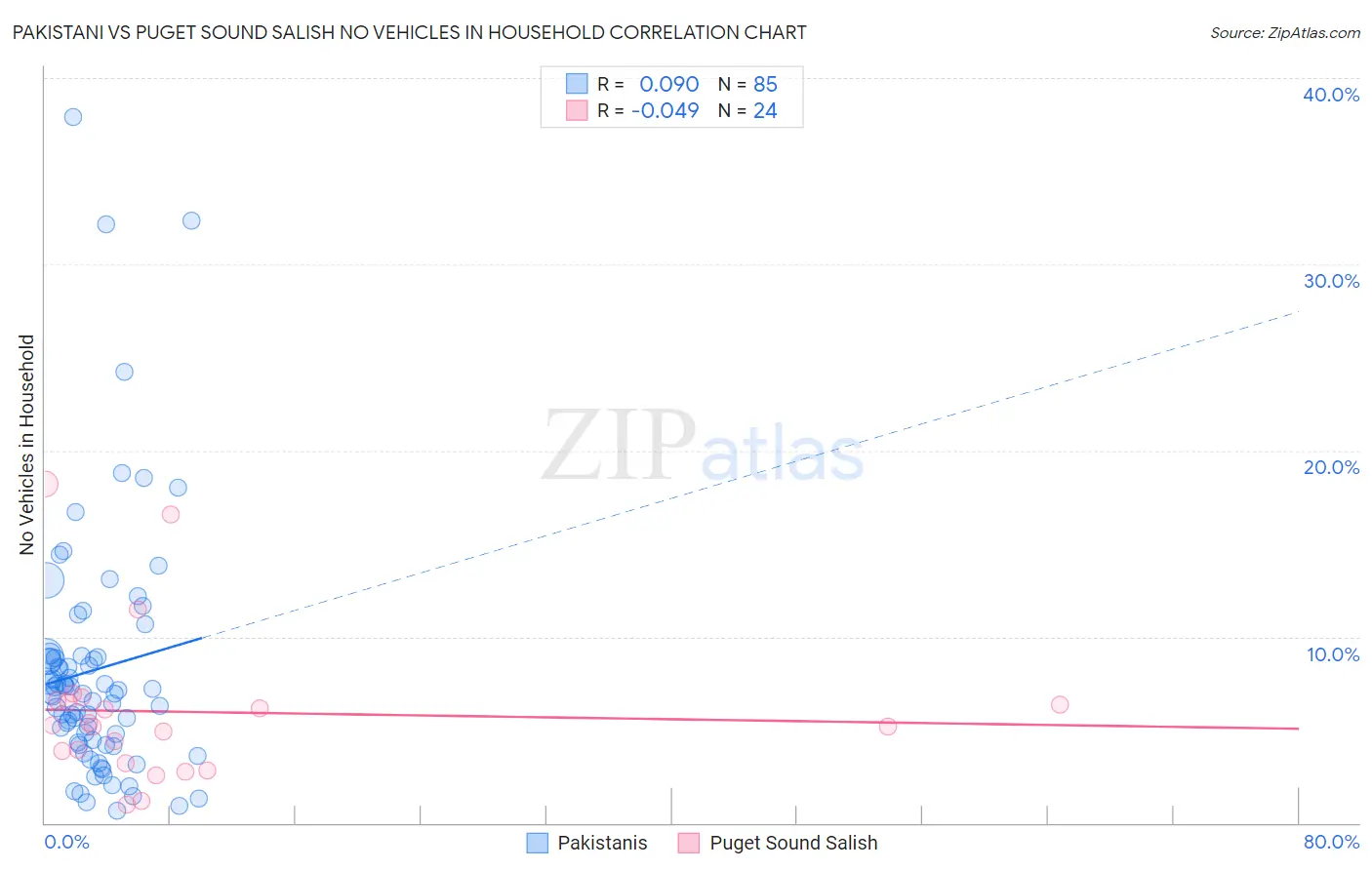Pakistani vs Puget Sound Salish No Vehicles in Household
COMPARE
Pakistani
Puget Sound Salish
No Vehicles in Household
No Vehicles in Household Comparison
Pakistanis
Puget Sound Salish
9.0%
NO VEHICLES IN HOUSEHOLD
98.3/ 100
METRIC RATING
101st/ 347
METRIC RANK
9.5%
NO VEHICLES IN HOUSEHOLD
92.4/ 100
METRIC RATING
121st/ 347
METRIC RANK
Pakistani vs Puget Sound Salish No Vehicles in Household Correlation Chart
The statistical analysis conducted on geographies consisting of 334,782,666 people shows a slight positive correlation between the proportion of Pakistanis and percentage of households with no vehicle available in the United States with a correlation coefficient (R) of 0.090 and weighted average of 9.0%. Similarly, the statistical analysis conducted on geographies consisting of 46,140,231 people shows no correlation between the proportion of Puget Sound Salish and percentage of households with no vehicle available in the United States with a correlation coefficient (R) of -0.049 and weighted average of 9.5%, a difference of 6.1%.

No Vehicles in Household Correlation Summary
| Measurement | Pakistani | Puget Sound Salish |
| Minimum | 0.66% | 0.96% |
| Maximum | 37.9% | 18.2% |
| Range | 37.2% | 17.3% |
| Mean | 8.2% | 6.0% |
| Median | 6.9% | 5.2% |
| Interquartile 25% (IQ1) | 4.3% | 3.5% |
| Interquartile 75% (IQ3) | 8.9% | 6.5% |
| Interquartile Range (IQR) | 4.7% | 3.0% |
| Standard Deviation (Sample) | 6.7% | 4.2% |
| Standard Deviation (Population) | 6.6% | 4.1% |
Demographics Similar to Pakistanis and Puget Sound Salish by No Vehicles in Household
In terms of no vehicles in household, the demographic groups most similar to Pakistanis are Yugoslavian (9.0%, a difference of 0.050%), Seminole (9.0%, a difference of 0.050%), Zimbabwean (9.0%, a difference of 0.68%), Spanish American (9.1%, a difference of 0.84%), and Laotian (9.1%, a difference of 0.94%). Similarly, the demographic groups most similar to Puget Sound Salish are Immigrants from Thailand (9.5%, a difference of 0.10%), Fijian (9.5%, a difference of 0.16%), Greek (9.5%, a difference of 0.27%), Chippewa (9.4%, a difference of 0.82%), and Japanese (9.4%, a difference of 0.99%).
| Demographics | Rating | Rank | No Vehicles in Household |
| Pakistanis | 98.3 /100 | #101 | Exceptional 9.0% |
| Yugoslavians | 98.3 /100 | #102 | Exceptional 9.0% |
| Seminole | 98.3 /100 | #103 | Exceptional 9.0% |
| Zimbabweans | 98.0 /100 | #104 | Exceptional 9.0% |
| Spanish Americans | 97.9 /100 | #105 | Exceptional 9.1% |
| Laotians | 97.8 /100 | #106 | Exceptional 9.1% |
| Hispanics or Latinos | 97.7 /100 | #107 | Exceptional 9.1% |
| Mexican American Indians | 97.6 /100 | #108 | Exceptional 9.1% |
| Maltese | 97.6 /100 | #109 | Exceptional 9.1% |
| Delaware | 97.2 /100 | #110 | Exceptional 9.2% |
| Immigrants | Kuwait | 95.1 /100 | #111 | Exceptional 9.4% |
| Armenians | 95.0 /100 | #112 | Exceptional 9.4% |
| Immigrants | Netherlands | 94.8 /100 | #113 | Exceptional 9.4% |
| Serbians | 94.3 /100 | #114 | Exceptional 9.4% |
| Navajo | 94.2 /100 | #115 | Exceptional 9.4% |
| Japanese | 94.1 /100 | #116 | Exceptional 9.4% |
| Chippewa | 93.8 /100 | #117 | Exceptional 9.4% |
| Greeks | 92.9 /100 | #118 | Exceptional 9.5% |
| Fijians | 92.7 /100 | #119 | Exceptional 9.5% |
| Immigrants | Thailand | 92.6 /100 | #120 | Exceptional 9.5% |
| Puget Sound Salish | 92.4 /100 | #121 | Exceptional 9.5% |